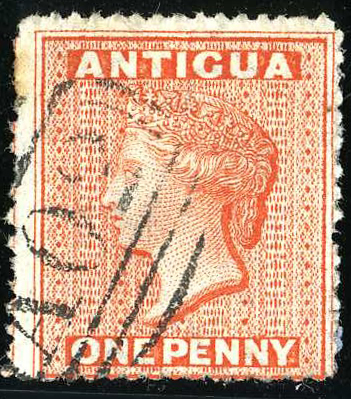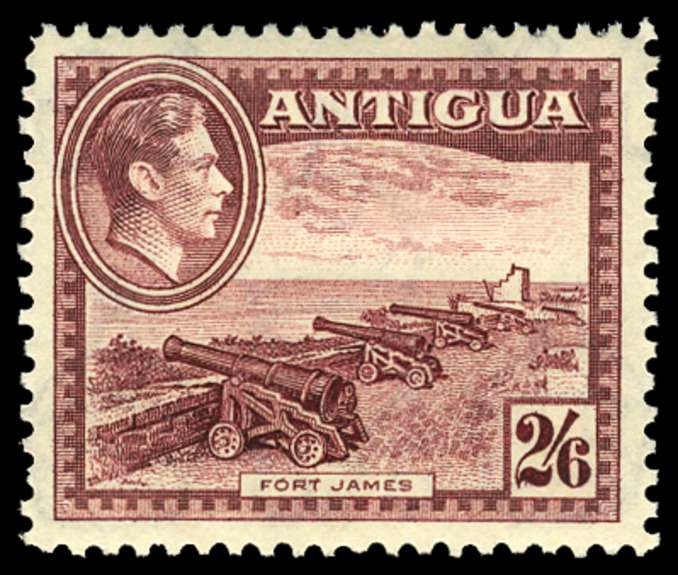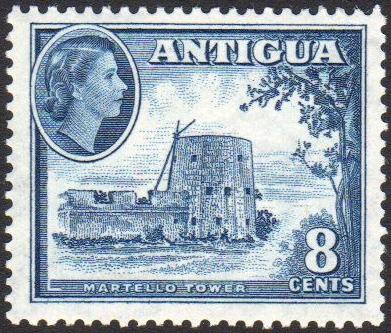Postage stamps and postal history of Antigua on:
[Wikipedia]
[Google]
[Amazon]
Antigua was discovered by
 The Post Office Act of Antigua, passed on 24 April 1860, by the Assembly of the Leeward Islands, transferred control to the local government. The first order for stamps was for a sixpence denomination to be used for the letter rate from Antigua to Great Britain. A consignment of 8,000 stamps, was sent out on 1 July 1862, by the printers, Messrs Perkins Bacon and Co. These arrived and were issued sometime in August 1862. A one penny stamp was issued in 1863. The design of these stamps is based on a drawing of Queen Victoria's head by Edward Henry Corbould and was engraved by Charles Henry Jeens. The plates from which Messrs Perkins Bacon and Co had printed all the Antiguan stamps up to that date were handed over to the new contractors for the colony, Messrs De la Rue and Co on 23 November 1871.
The Post Office Act of Antigua, passed on 24 April 1860, by the Assembly of the Leeward Islands, transferred control to the local government. The first order for stamps was for a sixpence denomination to be used for the letter rate from Antigua to Great Britain. A consignment of 8,000 stamps, was sent out on 1 July 1862, by the printers, Messrs Perkins Bacon and Co. These arrived and were issued sometime in August 1862. A one penny stamp was issued in 1863. The design of these stamps is based on a drawing of Queen Victoria's head by Edward Henry Corbould and was engraved by Charles Henry Jeens. The plates from which Messrs Perkins Bacon and Co had printed all the Antiguan stamps up to that date were handed over to the new contractors for the colony, Messrs De la Rue and Co on 23 November 1871.
 A 2½d and a 4d stamp, with a new design known as the "Key Plate", were issued in 1879, a ½d stamp was issued in 1882, a 2½d stamp in a changed colour and a one shilling value were issued in 1884, using the "Key Plate" design as before.
A 2½d and a 4d stamp, with a new design known as the "Key Plate", were issued in 1879, a ½d stamp was issued in 1882, a 2½d stamp in a changed colour and a one shilling value were issued in 1884, using the "Key Plate" design as before.

 Stamps of Antigua were used concurrently with issues of the Leeward Islands until 1956.
A total of seven different stamps were issued during the reign of
Stamps of Antigua were used concurrently with issues of the Leeward Islands until 1956.
A total of seven different stamps were issued during the reign of
Postage Stamps of Antigua (1856-1962)The first issues of Antigua.
* Stamps of the World http://stampsoftheworld.co.uk/wiki/Antigua {{PostalhistoryAmericas Philately of Antigua
Christopher Columbus
Christopher Columbus
* lij, Cristoffa C(or)ombo
* es, link=no, Cristóbal Colón
* pt, Cristóvão Colombo
* ca, Cristòfor (or )
* la, Christophorus Columbus. (; born between 25 August and 31 October 1451, died 20 May 1506) was a ...
, in 1493, and was named after the church of Santa Maria la Antigua in Seville. It was first settled in 1632. By the Treaty of Breda in 1667 it became a British Possession.
First stamps
The postal arrangements of Antigua were controlled by the British Postmaster General in London till 1 May 1860. The island authorities set up an internal post in March 1841, between St John's and English Harbour, with Mr Scotland as the postmaster. From 1858 Great Britain stamps were made available for use in Antigua. Letters from St John's were postmarked “A02” and those from English Harbour were obliterated with “A18”. The Post Office Act of Antigua, passed on 24 April 1860, by the Assembly of the Leeward Islands, transferred control to the local government. The first order for stamps was for a sixpence denomination to be used for the letter rate from Antigua to Great Britain. A consignment of 8,000 stamps, was sent out on 1 July 1862, by the printers, Messrs Perkins Bacon and Co. These arrived and were issued sometime in August 1862. A one penny stamp was issued in 1863. The design of these stamps is based on a drawing of Queen Victoria's head by Edward Henry Corbould and was engraved by Charles Henry Jeens. The plates from which Messrs Perkins Bacon and Co had printed all the Antiguan stamps up to that date were handed over to the new contractors for the colony, Messrs De la Rue and Co on 23 November 1871.
The Post Office Act of Antigua, passed on 24 April 1860, by the Assembly of the Leeward Islands, transferred control to the local government. The first order for stamps was for a sixpence denomination to be used for the letter rate from Antigua to Great Britain. A consignment of 8,000 stamps, was sent out on 1 July 1862, by the printers, Messrs Perkins Bacon and Co. These arrived and were issued sometime in August 1862. A one penny stamp was issued in 1863. The design of these stamps is based on a drawing of Queen Victoria's head by Edward Henry Corbould and was engraved by Charles Henry Jeens. The plates from which Messrs Perkins Bacon and Co had printed all the Antiguan stamps up to that date were handed over to the new contractors for the colony, Messrs De la Rue and Co on 23 November 1871.
 A 2½d and a 4d stamp, with a new design known as the "Key Plate", were issued in 1879, a ½d stamp was issued in 1882, a 2½d stamp in a changed colour and a one shilling value were issued in 1884, using the "Key Plate" design as before.
A 2½d and a 4d stamp, with a new design known as the "Key Plate", were issued in 1879, a ½d stamp was issued in 1882, a 2½d stamp in a changed colour and a one shilling value were issued in 1884, using the "Key Plate" design as before.
King Edward VII
Between 31 October 1890 and July 1903 Leeward Islands stamps were used in Antigua. At a meeting on 29 June 1903 the Executive Council of the Leeward Islands authorised separate issue for each of the islands to be used concurrently with those of the Leeward Islands. Ten values, from ½d to 2s 6d, showing the Royal Arms and the Seal of Antigua and a 5s showing the head of King Edward VII were issued in July 1903.
Later issues
 Stamps of Antigua were used concurrently with issues of the Leeward Islands until 1956.
A total of seven different stamps were issued during the reign of
Stamps of Antigua were used concurrently with issues of the Leeward Islands until 1956.
A total of seven different stamps were issued during the reign of Queen Victoria
Victoria (Alexandrina Victoria; 24 May 1819 – 22 January 1901) was Queen of the United Kingdom of Great Britain and Ireland from 20 June 1837 until her death in 1901. Her reign of 63 years and 216 days was longer than that of any previo ...
( 1837-1901 ) and ten different stamps were issued during the reign of King Edward VII
Edward VII (Albert Edward; 9 November 1841 – 6 May 1910) was King of the United Kingdom of Great Britain and Ireland and Emperor of India, from 22 January 1901 until his death in 1910.
The second child and eldest son of Queen Victoria and ...
( 1901-1910 ). During the reign of King George V
George V (George Frederick Ernest Albert; 3 June 1865 – 20 January 1936) was King of the United Kingdom and the British Dominions, and Emperor of India, from 6 May 1910 until his death in 1936.
Born during the reign of his grandmother Qu ...
( 1910-1936 ) a total of 29 different stamps were issued and 25 stamps were issued during the reign of George VI
George VI (Albert Frederick Arthur George; 14 December 1895 – 6 February 1952) was King of the United Kingdom and the Dominions of the British Commonwealth from 11 December 1936 until his death in 1952. He was also the last Emperor of I ...
( 1936-1952 ). Since 1953 some 3,000 different stamps have been issued to date.
Barbuda issues
Stamps were issued for Barbuda from 1922 to 1924, overprinting on stamps of the Leeward Islands.Independence
On 1 November 1981, the island withBarbuda
Barbuda (), is an island located in the eastern Caribbean forming part of the sovereign state of Antigua and Barbuda. It is located north of the island of Antigua and is part of the Leeward Islands of the West Indies. The island is a popula ...
and the island of Redonda
Redonda is an uninhabited Caribbean island that is a part of Antigua and Barbuda, in the Leeward Islands, West Indies. The island is about long, wide, and is high at its highest point.
This small island lies between the islands of Nevis and ...
gained independence as Antigua and Barbuda.
Stamps were again issued for Barbuda between 1967 and 2000, and for Redonda, which is uninhabited, between 1979 and 1991.
Postal stationery
In comparison to stamps Antigua has issued very littlepostal stationery
A piece of postal stationery is a stationery item, such as a stamped envelope, letter sheet, postal card, lettercard, aerogram or wrapper, with an imprinted stamp or inscription indicating that a specific rate of postage or related serv ...
, in fact the total to about 1990 is 23 items.
*A total of six different postcard
A postcard or post card is a piece of thick paper or thin cardboard, typically rectangular, intended for writing and mailing without an envelope. Non-rectangular shapes may also be used but are rare. There are novelty exceptions, such as wood ...
s have been issued, one in 1880, two in 1886, one in 1903 and one in 1924. Three reply postcards have been issued, two in 1886 and one in 1903.
*Only two postal stationery envelopes have ever been issued, a 1d and a 2½d, both in 1903.
*A total of nine registration envelopes were issued, if different sizes are counted. Two in 1903, four in 1924 and three in 1959.
*In 1967 the only aerogramme
An aerogram, aerogramme, aérogramme, air letter or airletter is a thin lightweight piece of foldable and gummed paper for writing a letter for transit via airmail, in which the letter and envelope are one and the same. Most postal administration ...
from the island was issued.
*Two newspaper wrapper
In philately a wrapper is a form of postal stationery which pays the cost of the delivery of a newspaper or a periodical. The wrapper is a sheet of paper, large enough to wrap around a folded or rolled newspaper and with an imprinted stamp to pay ...
s were issued in 1903.
See also
*Postage stamps and postal history of the Leeward Islands
The British Leeward Islands - Antigua, Dominica, Montserrat, Nevis, St. Christopher (St. Kitts), and the Virgin Islands all used postage stamps inscribed "LEEWARD ISLANDS" between 1890 and 1 July 1956, often concurrently with stamps inscribed with ...
*Revenue stamps of Antigua
The island of Antigua issued revenue stamps from 1870 to 1876. The island's short life as a revenue stamp-issuing country was mainly due to the use of postage stamps for most fiscal purposes from 1862 to 1870, and again from 1890 onwards. Therefore ...
* British Caribbean Philatelic Study Circle
* British West Indies Study Circle
References
Further reading
* Bacon, E. D. ''Stamps of Antigua printed by Perkins, Bacon and Company''. Boston: Mekeel, Severn, Wylie Company, 1908 * Cornell, W.G. and F.R. Saunders. ''Antigua: The Definitive Series of King George VI''. Southampton: King George VI Collectors Society, 1975 28p. Study paper; no. 7. * Freeland, Charles & John M Jordan. ''Antigua: The Stamps and Postal History''. Javea (Spain): British West Indies Study Circle, 2016 299p. * Lowe, Robson. ''The Codrington Correspondence, 1743-1851: being a study of a recently discovered dossier of letters from the West Indian islands of Antigua and Barbuda mostly addressed to the Codringtons of Dodington''. London: Robson Lowe, 1951 112p. * Melville, Fred. ''Antigua''. London: The Philatelic Institute, 1929 57p. See reference 1 above.External links
Postage Stamps of Antigua (1856-1962)
* Stamps of the World http://stampsoftheworld.co.uk/wiki/Antigua {{PostalhistoryAmericas Philately of Antigua